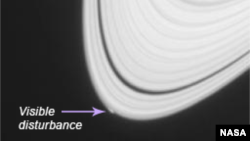Astronomers around the world are hoping a newly released image from the far reaches of our solar system is the never before seen birth of a new moon.
NASA's spacecraft Cassini, in orbit around Saturn, sent a photo of a bright protrusion on the edge of one of the planet's outer rings. It may be a gravitational disturbance caused by a small moon, tentatively named Peggy.
The mysterious feature, about 20 percent brighter than the surrounding material, is estimated to be 1,200 kilometers long and 10 kilometers wide, but it could have been caused by a much smaller moon - only 800 meters across.
Although excited about the possibility of studying the process of a moon formation, astronomers warn that the disturbance could have been caused by the breakup of an overlooked moon. Saturn has more than 150 moons and moonlets.
The photo was sent exactly a year ago, but the discovery was published today in the planetary science journal Icarus.
In two years, Cassini will pass much closer to the area with the gravitational disturbance giving astronomers an opportunity for a closer observation.
NASA's spacecraft Cassini, in orbit around Saturn, sent a photo of a bright protrusion on the edge of one of the planet's outer rings. It may be a gravitational disturbance caused by a small moon, tentatively named Peggy.
The mysterious feature, about 20 percent brighter than the surrounding material, is estimated to be 1,200 kilometers long and 10 kilometers wide, but it could have been caused by a much smaller moon - only 800 meters across.
Although excited about the possibility of studying the process of a moon formation, astronomers warn that the disturbance could have been caused by the breakup of an overlooked moon. Saturn has more than 150 moons and moonlets.
The photo was sent exactly a year ago, but the discovery was published today in the planetary science journal Icarus.
In two years, Cassini will pass much closer to the area with the gravitational disturbance giving astronomers an opportunity for a closer observation.










